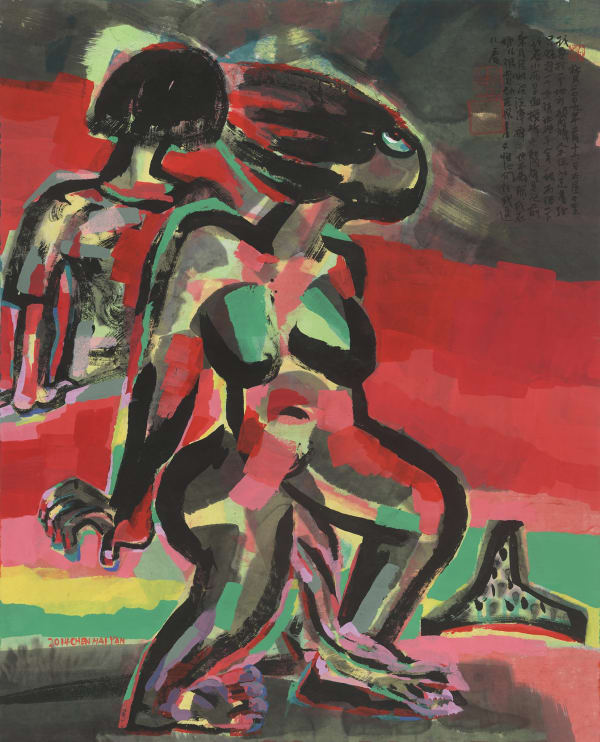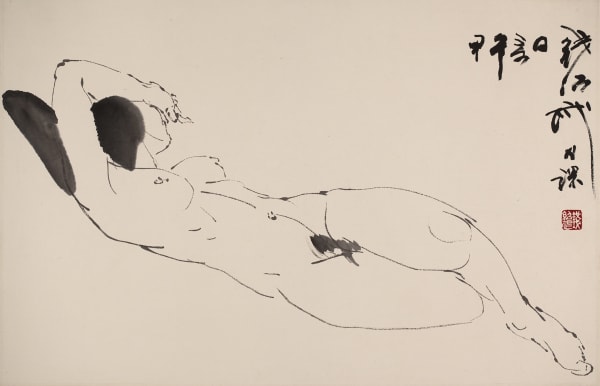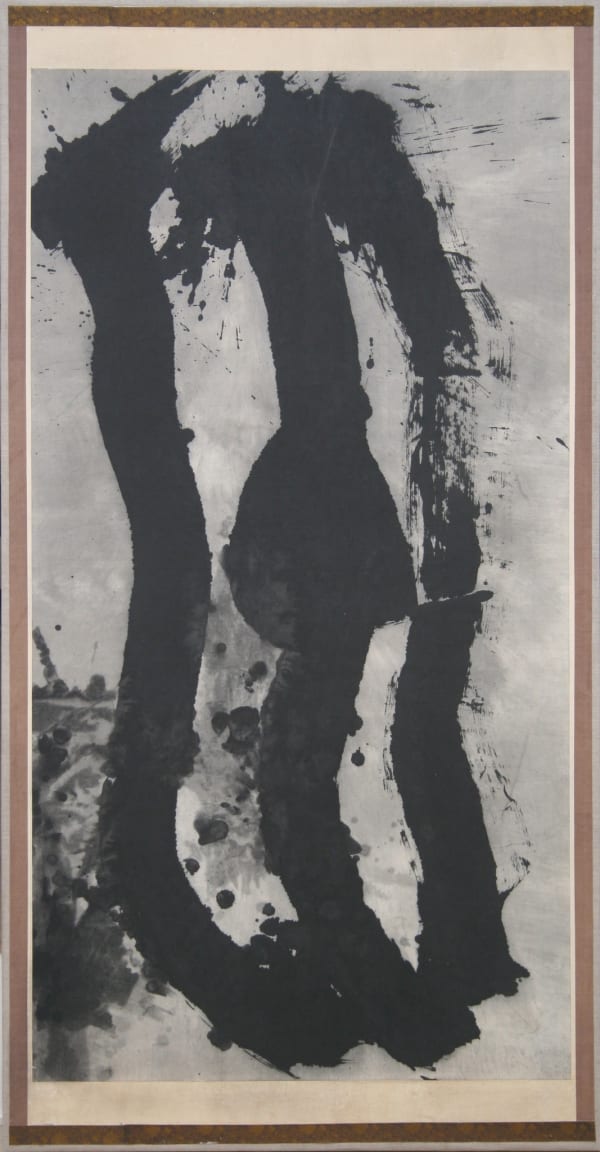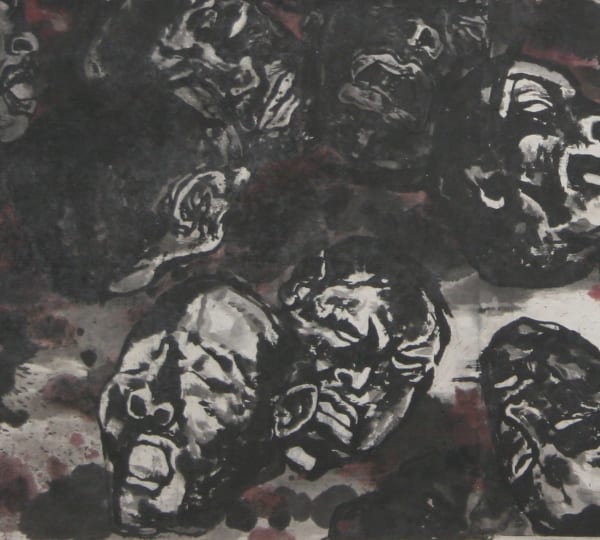INK AND THE BODY: Ink and Phenomenology, Exhibition No. 1
Ink Studio’s premier group show, Ink and the Body, launches a planned series of three exhibitions examining ink painting in terms of the relationship between the subject and both the artist and viewer, from a phenomenological perspective. The series consists of Ink and the Body, Ink and the Mind, and Ink and the Environment.
Ink and the Body explores the multivalent interactions between the human body and Chinese ink: of necessity, the body is the vehicle through which art is both created and perceived. Ideally, the experiencing of an ink painting that was created by an artist in full, instinctive control of the brush (or “in the zone”) can mirror the mental state involved in its creation. Thus, Ink and the Body is the logical entry point for an extended examination of the profound issues central to Chinese ink painting.
Much of contemporary Chinese ink painting relates to the body not only as the vehicle of creation, but also in more direct terms. At its most basic, this takes the form of direct impressions of the body, for example in Wang Peng’s ‘84s Performance — the first instance of nude performance art in China — and Zhang Yu’s ongoing series of fingerprint paintings, a fingerprint being an age-old identifying marker. The body becomes the medium of the exquisite and challenging performances by Dai Guangyu, in which ink is metaphorically conceived as nourishment and ritual fluid for the individual’s existence.
Tao Aimin focuses on the body’s action on the world, capturing the imprint of repetitive activity in her rubbings of old wooden washboards. Both the senior sculptor, Qian Shaowu, and renowned painter Li Jin paint images of the body, the latter humorous musings on the place of an individual in contemporary Chinese society, and the former based on European training in three-dimensional figural modeling, translated into ink painting. Chen Haiyan’s vivid images arise from her dreams, and reflect an understanding of color inspired by both the Expressionists and by mid-century master Zao Wuji’s encouragement of her personal color sense. Other artists focus on aspects of the body as metaphor; for example, Zhang Chunhong’s finely detailed renderings of her and her sisters’ long hair make statements concerning relationships and the place of the individual in the world.
Huang Zhiyang captures the sense of universal energy manifest in the body, and Zheng Chongbin considers the psyche as expressed via abstracted human forms. Yang Jiechang further abstracts the body in his starkly expressive Three Men Walking, based on a statement by Confucius. Finally, master calligrapher Wang Dongling reflects on the relationship between the body, the act of wielding the brush, and the different styles of calligraphy developed over the millennia.
-
 Chen Haiyan 陈海燕, Look into the Mirror 照镜子, 2014
Chen Haiyan 陈海燕, Look into the Mirror 照镜子, 2014 -
 Chen Haiyan 陈海燕, The Cloth Shelter 遮挡的布, 2014
Chen Haiyan 陈海燕, The Cloth Shelter 遮挡的布, 2014 -
 Dai Guangyu 戴光郁, Absorbing, Being Absorbed, Performance, Chengdu "吸纳.冥想" 行为, 成都, 1999
Dai Guangyu 戴光郁, Absorbing, Being Absorbed, Performance, Chengdu "吸纳.冥想" 行为, 成都, 1999 -
 Huang Zhiyang 黄致阳, Zoon-Beijing Bio No. 1001 Zoon-北京生物1001号, 2010
Huang Zhiyang 黄致阳, Zoon-Beijing Bio No. 1001 Zoon-北京生物1001号, 2010 -
 Li Jin 李津, Ink Hermit 泼墨山人, 2014
Li Jin 李津, Ink Hermit 泼墨山人, 2014 -
 Li Jin 李津, Ink Fairy 泼墨仙女, 2014
Li Jin 李津, Ink Fairy 泼墨仙女, 2014 -
 Qian Shaowu 钱绍武, Figure Line Drawing No. 3 人体线描3, 2014
Qian Shaowu 钱绍武, Figure Line Drawing No. 3 人体线描3, 2014 -
 Qian Shaowu 钱绍武, Figure Line Drawing No. 4 人体线描4, 2014
Qian Shaowu 钱绍武, Figure Line Drawing No. 4 人体线描4, 2014 -
 Qian Shaowu 钱绍武, Figure Line Drawing No. 9 人体线描9, 2014
Qian Shaowu 钱绍武, Figure Line Drawing No. 9 人体线描9, 2014 -
 Qian Shaowu 钱绍武, Figure Line Drawing No. 11 人体线描11, 2014
Qian Shaowu 钱绍武, Figure Line Drawing No. 11 人体线描11, 2014 -
 Tao Aimin 陶艾民, Washed Relics No. 2, Installation 出水文物之二,装置, 2014
Tao Aimin 陶艾民, Washed Relics No. 2, Installation 出水文物之二,装置, 2014 -
 Tao Aimin 陶艾民, The Secret Language of Women No. 1 女书一号, 2008
Tao Aimin 陶艾民, The Secret Language of Women No. 1 女书一号, 2008 -
 Tao Aimin 陶艾民, Woman's Journal No. 2 女书.手记之二, 2009
Tao Aimin 陶艾民, Woman's Journal No. 2 女书.手记之二, 2009 -
 Tao Aimin 陶艾民, Woman's Journal No. 10 女书.手记之十, 2009
Tao Aimin 陶艾民, Woman's Journal No. 10 女书.手记之十, 2009 -
 Tao Aimin 陶艾民, Woman's Journal No. 14 女书.手记之十四, 2009
Tao Aimin 陶艾民, Woman's Journal No. 14 女书.手记之十四, 2009 -
 Tao Aimin 陶艾民, Woman's Journal No. 18 女书.手记之十八, 2009
Tao Aimin 陶艾民, Woman's Journal No. 18 女书.手记之十八, 2009 -
 Tao Aimin 陶艾民, Woman's Journal No. 23 女书.手记之二十三, 2009
Tao Aimin 陶艾民, Woman's Journal No. 23 女书.手记之二十三, 2009 -
 Wang Dongling 王冬龄, Poem by Liu Xie(刘勰) 登山则情满于山,观海则意溢于海, 2014
Wang Dongling 王冬龄, Poem by Liu Xie(刘勰) 登山则情满于山,观海则意溢于海, 2014 -
 Wang Dongling 王冬龄, Poem by Nalanxingde 纳兰性德词, 2014
Wang Dongling 王冬龄, Poem by Nalanxingde 纳兰性德词, 2014 -
 Wang Dongling 王冬龄, Poem by Su Manshu 苏曼殊《本事诗》, 2014
Wang Dongling 王冬龄, Poem by Su Manshu 苏曼殊《本事诗》, 2014 -
 Wang Dongling 王冬龄, Poem by Wei Zhuang 韦庄《浣溪沙》, 2014
Wang Dongling 王冬龄, Poem by Wei Zhuang 韦庄《浣溪沙》, 2014 -
 Wang Dongling 王冬龄, Quotations from the Scholar Xiangshan 象山语录, 2014
Wang Dongling 王冬龄, Quotations from the Scholar Xiangshan 象山语录, 2014 -
 Wang Dongling 王冬龄, “Jing” (Water Well) 井, 2014
Wang Dongling 王冬龄, “Jing” (Water Well) 井, 2014 -
 Wang Peng 王蓬, 84 Performance (Ink 84-1) 84行为艺术, 1984
Wang Peng 王蓬, 84 Performance (Ink 84-1) 84行为艺术, 1984 -
 Wang Peng 王蓬, 84 Performance (Ink 84-4) 84行为艺术, 1984
Wang Peng 王蓬, 84 Performance (Ink 84-4) 84行为艺术, 1984 -
 Wang Peng 王蓬, 84 Performance (12Photos) 84行为艺术, 1984
Wang Peng 王蓬, 84 Performance (12Photos) 84行为艺术, 1984 -
 Yang Jiechang 杨诘苍, Massacre 屠杀, 1982
Yang Jiechang 杨诘苍, Massacre 屠杀, 1982 -
 Yang Jiechang 杨诘苍, Three Men Walking 三人行, 1987
Yang Jiechang 杨诘苍, Three Men Walking 三人行, 1987 -
 Zhang Chunhong 张春红, Waves 波浪, 2013
Zhang Chunhong 张春红, Waves 波浪, 2013 -
 Zhang Yu 张羽, Fingerprints 2010. 7-2 指印2010. 7-2, 2010
Zhang Yu 张羽, Fingerprints 2010. 7-2 指印2010. 7-2, 2010 -
 Zheng Chongbin 郑重宾, Another State of Man No. 6 人的另类状态6号, 1987
Zheng Chongbin 郑重宾, Another State of Man No. 6 人的另类状态6号, 1987 -
 Zheng Chongbin 郑重宾, Another State of Man No. 7 人的另类状态7号, 1988
Zheng Chongbin 郑重宾, Another State of Man No. 7 人的另类状态7号, 1988 -
 Zheng Chongbin 郑重宾, Another State of Man N0. 15 人的另一种状态 15 号, 1987
Zheng Chongbin 郑重宾, Another State of Man N0. 15 人的另一种状态 15 号, 1987 -
 Zheng Chongbin 郑重宾, Another State of Man No. 20 人的另一种状态20号, 1988
Zheng Chongbin 郑重宾, Another State of Man No. 20 人的另一种状态20号, 1988 -
 Zheng Chongbin 郑重宾, Another State of Man No. 25 人的另一种状态25号, 1988
Zheng Chongbin 郑重宾, Another State of Man No. 25 人的另一种状态25号, 1988
















































